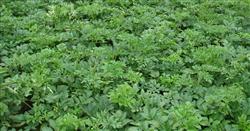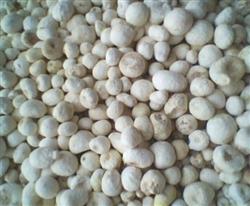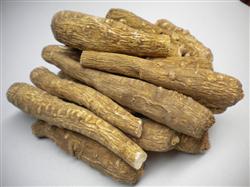Planting techniques of traditional Chinese Medicine Angelica dahurica

Introduction to the planting techniques of Angelica dahurica: (1) selection and preparation of Angelica dahurica should be cultivated on flat land. It is better to have a deep, loose and fertile sandy loam. The previous crop is generally rice, corn, sorghum, cotton and so on. After the previous crop harvest, apply rotten compost per mu, or 5000 kg of barnyard manure and 50 kg of phosphate fertilizer as base fertilizer. Then ploughing, a depth of about 25 Mel 30 cm, leveling and raking fine, to make a high border. (2) planting method 1. The sowing time is divided into autumn sowing and spring sowing, and autumn sowing is better. It is suitable for the Autumn Equinox to Cold Dew, sowing too early, Angelica dahurica plants grow too prosperous in that year, some plants sprout and blossom ahead of time in the second year, and the root Lignification can not be used medicinally. Sowing too late, less precipitation in winter, low temperature, not easy to germinate after sowing, affecting growth. Sowing method: both strip sowing and hole sowing can be sowed without covering the soil, and then apply dilute human and animal dung water, about 1000 kg per mu, and then cover it with plant ash mixed with human and animal dung water, without exposing seeds. Then use a plank to suppress or tread lightly, so that the seeds and soil close to facilitate germination. The seedlings can emerge in 15-20 days. (3) Field management 1. Time seedlings with a height of 4-7 cm after emergence can be carried out 1-2 times. There are 5-8 seedlings planted in holes and 1 seedling every 7-10 cm in strip sowing. The seedlings were fixed according to the plant spacing of 10-12 cm. When interseedling, leave the strong seedling with bluish purple petiole or flat base of the plant, leaving it in the shape of triangle or plum blossom to facilitate ventilation and light transmission. 2. Loosening soil and weeding combined with inter-seedling weeding. Weeding at the seedling stage should be carried out with a shallow hoe, and the weeding can be carried out later, so that the soil in the field is loose and free of weeds, so as to facilitate growth. 3. Fertilizing and topdressing for 3-4 times. The first and second times were carried out after inter-seedling and inter-tillage. 1500-2000 kg of sparse human and animal manure per mu each time. The third time after the seedling was fixed, 2000-3000 kg of human and animal manure water per mu and 3 kg of urea were added. Ching Ming Festival was fertilized for the fourth time before and after applying 2000-3000 kg of human and animal manure per mu and 150kg of plant ash. 4. The soil of Angelica dahurica is dry after drainage and irrigation, so it should be irrigated in time to keep the soil moist to facilitate seedling emergence. During the growing period, if the weather is dry, it should be watered in time to ensure the needs of plant growth. when Rain Water is too much or stagnant water in the field, it should be drained in time to prevent disease or rotting roots. (4) Prevention and control of diseases and insect pests: 1. Disease spot blight: also known as white spot disease, leaf spot disease, is a half-known fungus in fungi. Damage the leaves. The plaque begins to be small, dark green at first, grayish white after enlargement, and when severe, the plaque converges into a polygonal spot. In the later stage, there were dense small black spots on the disease spot of the diseased leaf (that is, the conidium of the pathogen), and the leaf withered locally or completely. The disease usually occurs in May until the harvest. If there is too much nitrogen fertilizer, the plant is too dense, and it is also easy to get sick. Control methods: strong and disease-free plants were selected to leave seeds. Angelica dahurica At the initial stage of the disease, the diseased leaves were removed and 1 ∶ 1 ∶ Bordeaux solution was sprayed for 1-2 times. Purple feather disease: a pathogen in fungi. Fuchsia mycelium bundles are often entangled and irrigated on the main root, causing the root epidermis to rot. In poor drainage or humid low-lying areas, the disease is serious. Prevention and control methods: make a high border to facilitate drainage; use 70% pentachloronitrobenzene powder, 2 kg per mu plus 20 kg plant ash, and spread the soil evenly, and prepare the soil for many times; you can also use 70% dimethopone wettable powder 2 kg per mu, pour 2000 kg of water on the border surface, and then sow the soil after the soil is dry. Rhizoctonia solani: a half-known fungus in fungi. It mostly occurs when it is overcast and rainy in early spring, the soil is heavy and the air permeability is poor. At the initial stage of the disease, the yellow-brown disease spot appeared at the base of the seedling, and then the base showed a brown ring dry shrinkage depression until the plant died. Control methods: select sandy loam for planting and remove stagnant water in time; at the initial stage of the disease, 5% lime water is infused, once every 7 days, 3-4 times in a row, or 1 ∶ 25 pentachloronitrobenzene fine soil is scattered around the diseased plant. Black spot: black spots appear on autumn leaves. Methods of prevention and treatment: remove diseased leaves or spray Bordeaux solution with 1 ∶ 1 ∶ 120 for 2 times. 2. insect pests: yellow-winged fennel borer, yellow Phoenix butterfly, aphids, red spiders, harmful to leaves. Control method: spray with 90% crystal trichlorfon 1 000 times or 40% dimethoate EC 2 000 times. Black Tsui: harms the root. Control method: irrigate the soil around the root of the plant with 1000 times of 25% ammonium parathion EC. Heart-eating insect: bites the seed, often makes the seed grain no harvest. Control method: spray with 1000 times liquid of 90% crystal trichlorfon. Ground tiger: harms the young stem of the plant. Prevention and control method: use artificial hunting or poison bait to kill. Click to get more planting techniques of Angelica dahurica
- Prev

How to plant Pinellia ternata for high yield
How can Pinellia ternata be planted with high yield? Please give an introduction to planting Pinellia ternata in order to achieve high yield, it is necessary to understand its growth habits. References are as follows: 1 morphological characteristics of perennial herbs, underground tuber bulbs are oblate, with a diameter of 1mi 2 cm, and most fibrous roots in the lower part. The 1-year-old leaves are simple, and the 2-3-year-old leaves are deeply divided.
- Next

How to grow Chinese herbal medicine Angelica dahurica?
How to grow Chinese herbal medicine Angelica dahurica? What are the environmental requirements of Angelica dahurica? please introduce the cultivation techniques of Angelica dahurica: 1. the biological characteristics of Angelica dahurica dahuricae dahur 1. The experimental study on the requirement of light found that light can promote the species of Angelica dahurica.
Related
- Fuxing push coffee new agricultural production and marketing class: lack of small-scale processing plants
- Jujube rice field leisure farm deep ploughing Yilan for five years to create a space for organic food and play
- Nongyu Farm-A trial of organic papaya for brave women with advanced technology
- Four points for attention in the prevention and control of diseases and insect pests of edible fungi
- How to add nutrient solution to Edible Fungi
- Is there any good way to control edible fungus mites?
- Open Inoculation Technology of Edible Fungi
- Is there any clever way to use fertilizer for edible fungus in winter?
- What agents are used to kill the pathogens of edible fungi in the mushroom shed?
- Rapid drying of Edible Fungi

